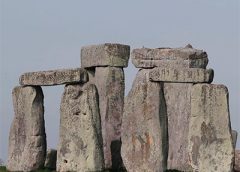Recent Research Has Finally Confirmed The Source Of The Megalith’s Mammoth Sarsen Stones.
By Mark S. Kuhar
The first monument at England’s famous megalith Stonehenge was a circular earthwork enclosure, built in about 3,000 BC. A ditch was dug with simple antler tools, and the chalk piled up to make an inner and an outer bank. Within the ditch was a ring of 56 timber or stone posts.
The monument was used as a cremation cemetery for several hundred years.
In about 2,500 BC the site was transformed by the construction of the central stone settings. Enormous sarsen stones and smaller bluestones were raised to form a unique monument. Building Stonehenge took huge effort from hundreds of well-organized people.
There are two types of stone at Stonehenge – the larger sarsen stones and the smaller “bluestones.”
The sarsen stones are a type of silcrete rock, which is found scattered naturally across southern England. For many years, most archaeologists believed that these stones were brought from the Marlborough Downs, 20 miles (32 km) away, but their exact origin remained a mystery.
However, recent research using a novel geochemical approach has not only confirmed that the Marlborough Downs were indeed the source but has pinpointed the specific area that the sarsens most likely came from – the area known as West Woods, southwest of Marlborough.
On average the sarsens weigh 25 tons, with the largest stone, the Heel Stone, weighing about 30 tons.
Bluestone is the term used to refer to the smaller stones at Stonehenge. These are of varied geology but all came from the Preseli Hills in southwest Wales. Although they may not appear blue, they do have a bluish tinge when freshly broken or when wet. They weigh between 2 and 5 tons each.
Some people believe that the bluestones could have been brought to Salisbury Plain by the movement of glaciers, but most archaeologists think that they were transported by human effort. How this was done over a distance of more than 250 km remains unknown, but it is probable that the stones were both carried via water networks and hauled over land.
The Altar Stone is made of a type of sandstone found in southeast Wales, in the area of the Brecon Beacons or Black Mountains.
Large quantities of sarsen and bluestone waste material, as well as broken hammerstones, have been found in the field to the north of Stonehenge, where the stones were worked into shape. Sarsen and flint hammerstones in various sizes have been found at Stonehenge. The larger ones would have been used to roughly flake and chip the stone, and the smaller to finish and smooth the surfaces.
Analysis of a recent laser survey of the stones has revealed the different stone-working methods used and has shown that some parts of the monument were more carefully finished than others. In particular, the northeast side and the inner faces of the central trilithons were finely dressed.
To fit the upright stones with the horizontal lintels, mortice holes and protruding tenons were created. The lintels were slotted together using tongue and groove joints. These types of joint are usually found only in woodworking.
To erect a stone, people dug a large hole with a sloping side. The back of the hole was lined with a row of wooden stakes. The stone was then moved into position and hauled upright using plant fiber ropes and probably a wooden A-frame. Weights may have been used to help tip the stone upright. The hole was then packed securely with rubble.
Timber platforms were probably used to raise the horizontal lintels into position. Then, the final stage of shaping the tenons took place, to ensure a good fit into the mortice holes of the lintel.
Source: English Heritage, www.english-heritage.org.uk

